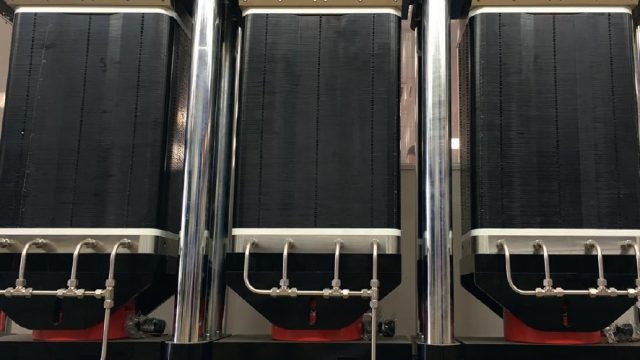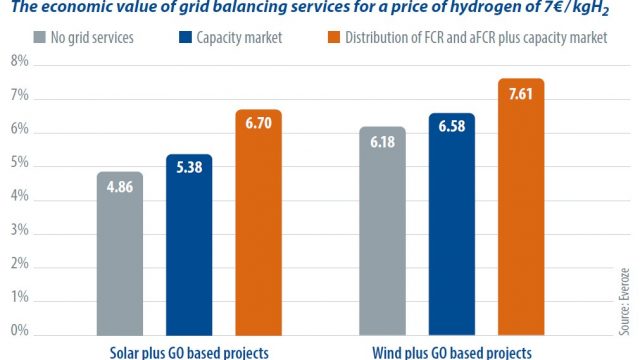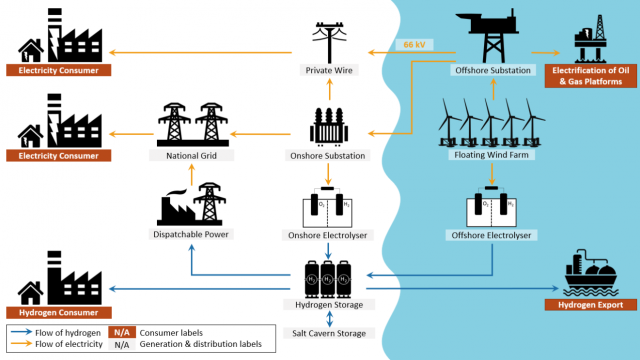Ambitious EU targets for green hydrogen
As published in PV Magazine December 2023
The pivotal role of green hydrogen in decarbonizing the economy is unquestioned, but how should projects be sizing electrolysers and green electricity supply? Everoze Partner Alexia Chappond describes several scenarios taking shape in projects that are currently under development.
The European Union has decided to drastically reduce greenhouse gas emissions and increase green hydrogen production. The target is the local production of 10 million tons of renewable hydrogen (as well as imports of 10 million tons) per year by 2030. In 2022, Europe produced only 16,000 tons of hydrogen from water electrolysis, according to the European Hydrogen Observatory, and not all of that was powered by green electricity.
To be considered green, hydrogen must be correlated with the generation of green electricity. How can green hydrogen projects secure enough green electricity? This becomes a question of sizing the electrolyser and securing green electricity input at the same time. Until 2030, regulations stipulate a monthly correlation with the generation of renewable energy, but after 2030, this will have to become hourly.

Photo – ITM Power
Green grid power
It is possible to just design an electrolyser project and buy the green electrons from the grid. That is simply a matter of finding an electricity supply contract with a major company that has good offers for green electricity. That appears straightforward enough but the price of the electricity becomes decisive given energy can represent more than half of the levelized cost of hydrogen (LCOH).
In 2020, the price of hydrogen was estimated to have been between €2.50 ($2.71)/ kg and €5.50/kg, for renewable hydrogen, and €2/kg for the fossil-fuelled form of the energy carrier. Since then, the price of natural gas has increased, but the difference is still significant, and projects are struggling to decrease their costs and become more competitive.
It is possible to negotiate more competitive electricity prices using one or more power purchase agreements (PPAs) but green PPAs have to be backed by new renewable energy assets, which is quite a challenge. Everyone wants to secure their electricity prices but more importantly, the European Commission doesn’t want electrolysers adding stress to the power grid. Green H2 production could represent 14% of European Union electricity consumption by 2030 (around 500 TWh) if European Union targets are reached. It is important that electrolysers don’t increase demand at peak times. Hydrogen will only be considered green if the electrolyser is fed by newly built renewable energy assets.

Photo Verdagy
Renewables co-location
This brings us to the last option: to design and build renewables assets specifically for electrolysers. This may sound like the best technical option but it will trigger a combination of financial risks with large amounts of capital expenditure (capex) that have to be invested at the same time and different development timelines needing to converge on the same commissioning date. This is the way to control the electricity price and the availability of given facilities. It also makes it possible to secure an offtake for RE production and reduce the risk of grid-related electricity curtailment.
The choice of RE sources, mix, and location will also determine the size and utilization rate of an electrolyser. While the capex costs are fixed, regardless of how long the electrolyser operates, it is essential to optimize the system as a whole. That is a financial calculation but obviously it is not possible to design RE assets to cover the maximal production of an electrolyser every hour.
Solar and wind are often complementary for shorter and longer periods, as solar production is higher during summer and available during the day, while wind is often higher during winter and at night. Other opportunities lie in hydropower plants. Hybridized electricity generation will average out the load factor and reduce seasonal variability and intermittency in hydrogen production.
Another consideration is whether green hydrogen production is going to fulfil the needs of the off taker. While it is possible to simply sell whatever green hydrogen is produced, many clients may have a specific demand pattern. This means that in addition to all the complexity mentioned above, production output will still need to be modulated. If a client needs hydrogen when it is not being produced, hydrogen storage significantly increases costs, so ensuring optimal sizing requires care.
A green electrolyser project is not as simple as a renewable energy project; it is not only about pushing green electrons to the grid. It is a multifactor puzzle that will require many iterations and a holistic approach to coordinate electricity generation, hydrogen production, and consumption. Resolving the complexity of green hydrogen projects will be necessary to progress to the next stage of the energy transition.






